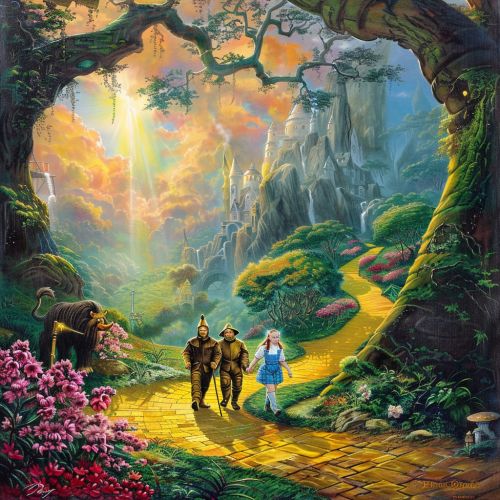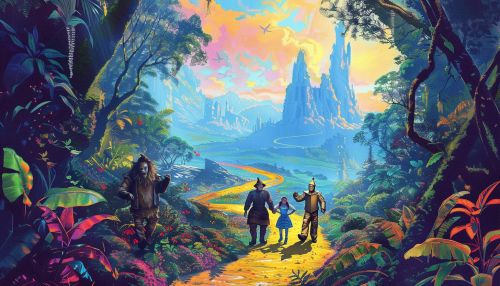The Wizard of Oz: Difference between revisions
(Created page with "== Overview == "The Wizard of Oz" is a classic American fantasy novel written by L. Frank Baum and originally published in 1900. The story chronicles the adventures of a young girl named Dorothy Gale in the magical land of Oz after she and her dog Toto are swept away from their Kansas home by a cyclone. The novel has been adapted into various media, including the iconic 1939 film adaptation, stage plays, and numerous television adaptations. This article delves deeply int...") |
No edit summary |
||
| Line 28: | Line 28: | ||
The Wicked Witch of the West is the primary antagonist. She seeks to avenge her sister's death and obtain Dorothy's silver shoes. Her character embodies evil and tyranny, serving as a foil to Dorothy's goodness. | The Wicked Witch of the West is the primary antagonist. She seeks to avenge her sister's death and obtain Dorothy's silver shoes. Her character embodies evil and tyranny, serving as a foil to Dorothy's goodness. | ||
[[Image:Detail-92779.jpg|thumb|center|Illustration of Dorothy, Scarecrow, Tin Woodman, and Cowardly Lion walking on the Yellow Brick Road through a lush, colorful landscape.|class=only_on_mobile]] | |||
[[Image:Detail-92780.jpg|thumb|center|Illustration of Dorothy, Scarecrow, Tin Woodman, and Cowardly Lion walking on the Yellow Brick Road through a lush, colorful landscape.|class=only_on_desktop]] | |||
== Themes == | == Themes == | ||
Latest revision as of 04:25, 21 June 2024
Overview
"The Wizard of Oz" is a classic American fantasy novel written by L. Frank Baum and originally published in 1900. The story chronicles the adventures of a young girl named Dorothy Gale in the magical land of Oz after she and her dog Toto are swept away from their Kansas home by a cyclone. The novel has been adapted into various media, including the iconic 1939 film adaptation, stage plays, and numerous television adaptations. This article delves deeply into the narrative structure, themes, characters, and cultural impact of "The Wizard of Oz."
Plot Summary
The narrative begins with Dorothy Gale living on a Kansas farm with her Aunt Em and Uncle Henry. A cyclone transports her and her dog Toto to the magical land of Oz. Upon arrival, Dorothy's house lands on the Wicked Witch of the East, killing her and freeing the Munchkins from her tyranny. The Good Witch of the North gives Dorothy the deceased witch's silver shoes and advises her to follow the Yellow Brick Road to the Emerald City to seek help from the Wizard of Oz.
During her journey, Dorothy befriends the Scarecrow, who desires a brain; the Tin Woodman, who longs for a heart; and the Cowardly Lion, who seeks courage. Together, they face various challenges, including an encounter with the Wicked Witch of the West, who seeks revenge for her sister's death. Ultimately, they reach the Emerald City, where the Wizard agrees to grant their wishes if they can bring him the Wicked Witch's broomstick.
After defeating the Wicked Witch of the West, the group returns to the Emerald City. The Wizard reveals himself as a humbug, but he still manages to fulfill the group's desires through clever means. Dorothy learns that she can return home by clicking her heels together three times while wearing the silver shoes. She awakens back in Kansas, realizing that her adventures in Oz may have been a dream.
Characters
Dorothy Gale
Dorothy is the protagonist of the story. She is characterized by her bravery, kindness, and determination. Her journey in Oz serves as a rite of passage, transforming her from a naive girl into a mature and resourceful individual.
Scarecrow
The Scarecrow is a companion of Dorothy who desires a brain. Despite believing himself to be unintelligent, he frequently displays wisdom and resourcefulness. His character explores themes of self-perception and the nature of intelligence.
Tin Woodman
The Tin Woodman, originally a human named Nick Chopper, desires a heart to feel emotions again. His character highlights the importance of compassion and the human condition. His backstory involves a curse by the Wicked Witch of the East, which turned his body into tin.
Cowardly Lion
The Cowardly Lion seeks courage, believing himself to be a coward. Throughout the journey, he demonstrates bravery, suggesting that true courage involves facing one's fears. His character serves as a commentary on the nature of bravery and self-doubt.
The Wizard of Oz
The Wizard is a mysterious figure who rules the Emerald City. Initially perceived as a powerful sorcerer, he is eventually revealed to be an ordinary man from Omaha, Nebraska, who arrived in Oz via a hot air balloon. His character explores themes of deception and the nature of power.
Wicked Witch of the West
The Wicked Witch of the West is the primary antagonist. She seeks to avenge her sister's death and obtain Dorothy's silver shoes. Her character embodies evil and tyranny, serving as a foil to Dorothy's goodness.


Themes
Good vs. Evil
The dichotomy of good versus evil is a central theme in "The Wizard of Oz." Dorothy and her companions represent good, while the Wicked Witches symbolize evil. The narrative explores the triumph of good over evil through courage, intelligence, and compassion.
Self-Discovery
Each main character undergoes a journey of self-discovery. Dorothy learns about her inner strength, the Scarecrow realizes his intelligence, the Tin Woodman discovers his capacity for love, and the Cowardly Lion finds his courage. The Wizard's revelation as a humbug further emphasizes the theme of self-reliance.
The Power of Friendship
The bond between Dorothy and her companions is a crucial element of the story. Their mutual support and cooperation enable them to overcome obstacles. This theme underscores the importance of camaraderie and collective effort.
Illusion vs. Reality
The Wizard's deception and the magical elements of Oz contrast with the stark reality of Kansas. The story blurs the lines between illusion and reality, prompting readers to question the nature of perception and belief.
Cultural Impact
"The Wizard of Oz" has had a profound impact on popular culture. The 1939 film adaptation, starring Judy Garland, is considered one of the greatest films of all time. The novel has inspired numerous adaptations, including stage musicals like "Wicked," which explores the backstory of the Wicked Witch of the West.
The story's characters and themes have become ingrained in American culture, with references appearing in various media. Phrases like "There's no place like home" and "We're not in Kansas anymore" have entered the cultural lexicon.
Adaptations
Film
The 1939 film adaptation directed by Victor Fleming is the most famous version of the story. It introduced iconic elements such as the ruby slippers (changed from silver in the book) and the song "Over the Rainbow." The film's use of Technicolor and special effects was groundbreaking for its time.
Stage
The story has been adapted into numerous stage productions, including the 1902 musical extravaganza and the 1975 Broadway musical "The Wiz," which reimagines the story with an African-American cast. "Wicked," a prequel focusing on the Wicked Witch of the West, has also achieved significant success.
Television
Television adaptations include animated series, live-action versions, and miniseries. Notable examples include the 1990 animated series "The Wizard of Oz" and the 2007 miniseries "Tin Man," which offers a darker, more modern take on the story.
